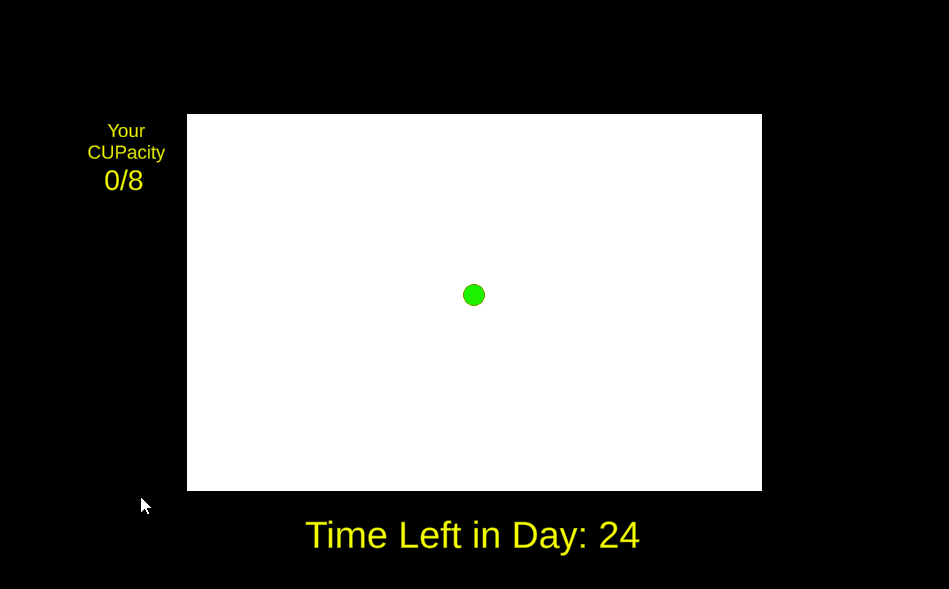
Stress CUPacity
An arcade avoid-’em-up about emotional overload and stress spillover.
Genre: Action / Arcade Dodge-Em
Role: Solo Developer
Engine: Unity (C#)
Team Size: 1
Duration: 7 Days
Platform: Web / PC
Play: https://yousayrandy.itch.io/stress-cupacity
Development Overview
Stress CUPacity was developed solo in 7 days for Brackey’s Game Jam 2022.1 under the theme “This Is Not Real.” The game explores psychological stress through fast-paced evasion gameplay and systems-driven emotional metaphors.
The player dodges abstract obstacles representing intrusive thoughts, while accumulating damage in a personal “stress cup.” Overflow begins to affect others—friends, family, loved ones—turning performance into a reflection of emotional collateral.
Therapy sessions between rounds allow players to focus on specific stressors, dynamically altering gameplay by making them appear less frequently—but never fully disappear.
Core Programming & Design Contributions
🧠 Stress & CUPacity System
Built a layered damage system simulating emotional bandwidth:
-
Player has a finite CUPacity before damage spills into others’ “cups.”
-
System scales across 8 cups using dynamic UI updates and serialized thresholds.
-
Implemented hit logic, invincibility windows, and sprite-based damage feedback (Unity Animation).
Designed to reflect emotional overload in tangible, escalating gameplay states.
⚙️ Anxiety Obstacle Framework
Each “stress” spawns as a patterned hazard with randomized intrusive thoughts:
-
Configured via ScriptableObjects and animation-based paths (e.g., $-shaped movement for financial stress).
-
Spawn behavior adjusts based on therapy selections, reducing frequency but maintaining impact.
-
Dialogue arrays inject flavor and overwhelm, contributing to intended sensory overload.
📈 Therapy-Based Modifier System
Therapy choices alter gameplay loop without removing core threats:
-
Eliminated early design flaw (invincibility after resolving a stressor) by pivoting to frequency reduction.
-
Coded modular condition-checks for each stressor to dynamically scale spawn intervals.
-
Balanced diminishing returns and cumulative escalation over time to maintain challenge.
🖥️ UI & Game Loop Architecture
Implemented full gameplay loop with minimal but functional UI:
-
Built stressor selection menus with variable cost tracking and tooltip messaging.
-
Tracked state with singleton managers and transition logic for round resets, win/loss, and progress saving.
-
Audio toggle system (via listener disable) and adaptive HUD that reacts to escalating stress states.
🎯 Design-for-Meaning Focus
Core mechanic designed as a metaphor:
-
You can’t eliminate stress—only manage how often it resurfaces.
-
Overflow affects others, tying performance to emotional awareness.
-
Choices in therapy matter, but they never make the game easy.
Challenges Tackled
✦ Overengineering vs. Deadline
Codebase leaned heavily on duplication and Update loops due to jam pressure:
-
Used placeholder assets and focused on logic over optimization.
-
Prioritized serialized variable exposure for quick tuning.
-
Built flexible but messy systems that worked under time constraints.
✦ Emotional Investment Mid-Jam
Major design flaw discovered late in development nearly tanked the project:
-
Original system rewarded therapy with immunity—killed challenge, broke metaphor.
-
Reframed around real-life analogy (you can manage stress, not erase it).
-
Refactored logic rapidly to shift core loop without overhauling entire structure.
Outcome
Stress CUPacity is unpolished, overloaded, and a little chaotic—by design. It translates psychological pressure into arcade mechanics, encouraging players to juggle survival with emotional management.
It taught me how to build game systems that say something—even when the code behind them is held together by duct tape and caffeine. Despite the mess, it works. And it connected with players more than I ever expected.
This one meant something.
